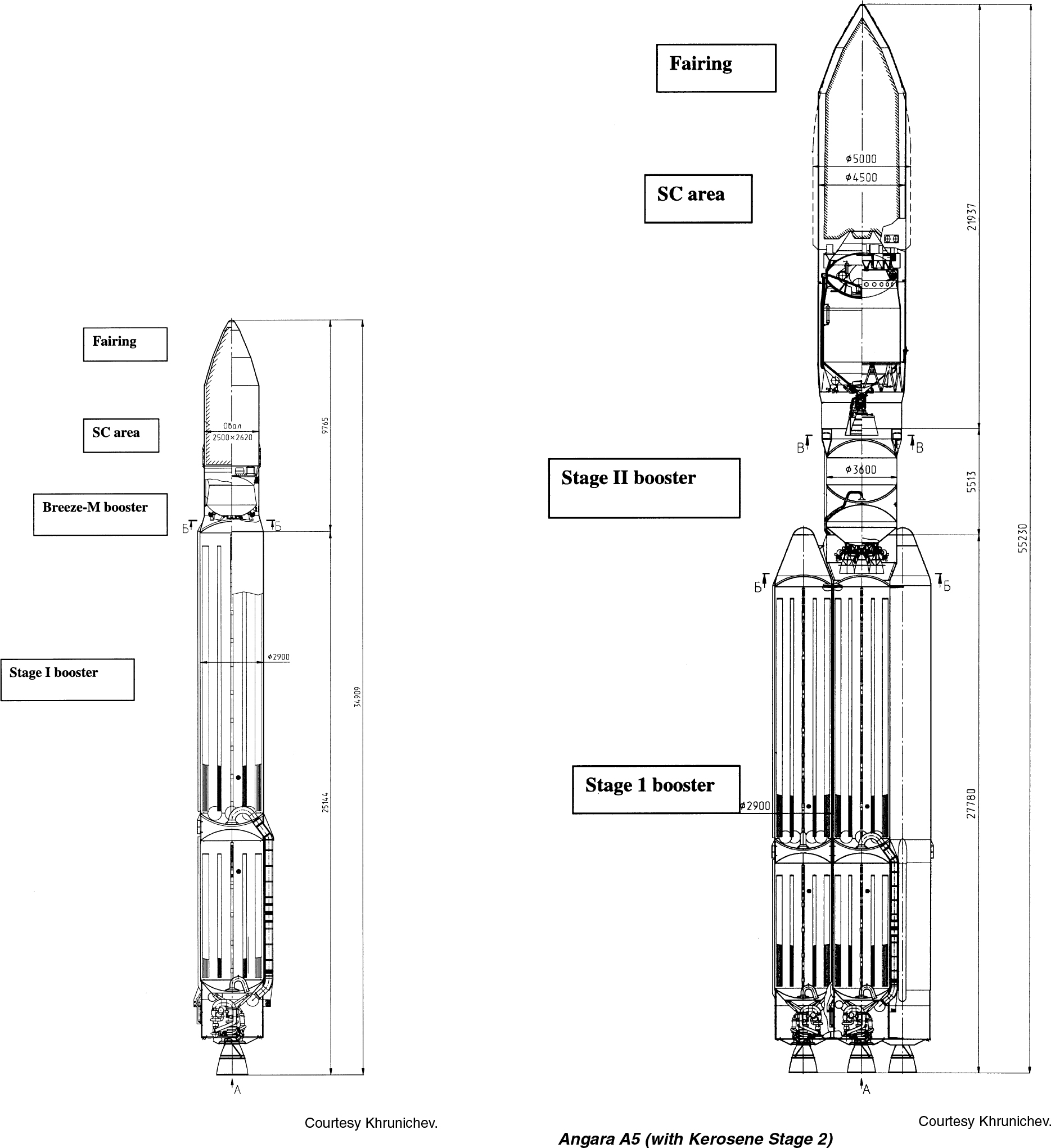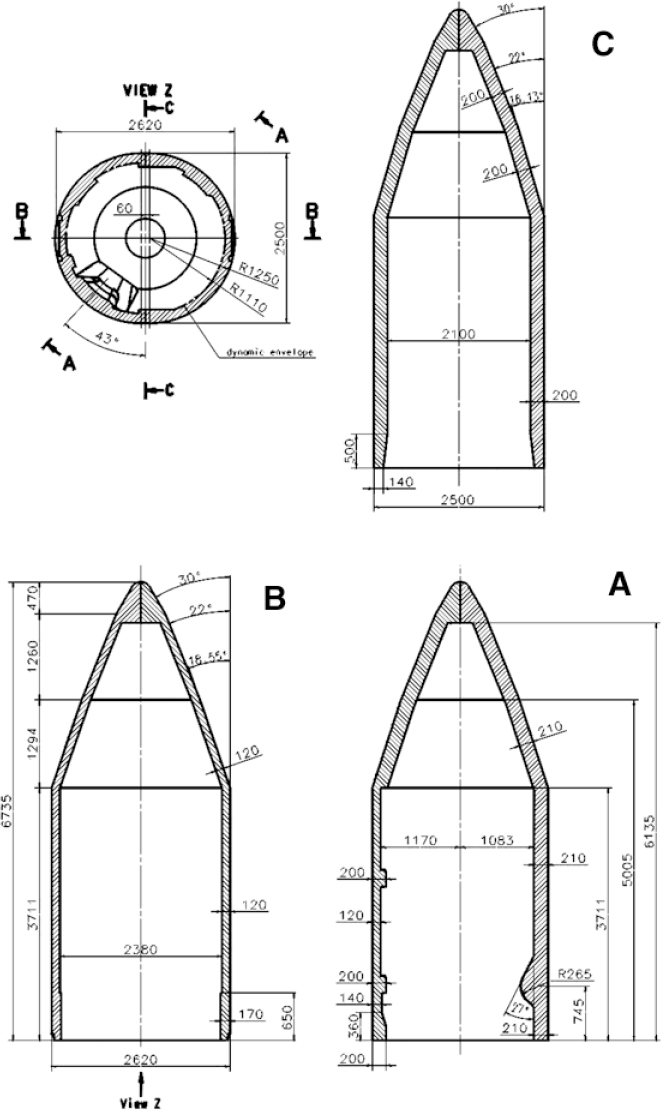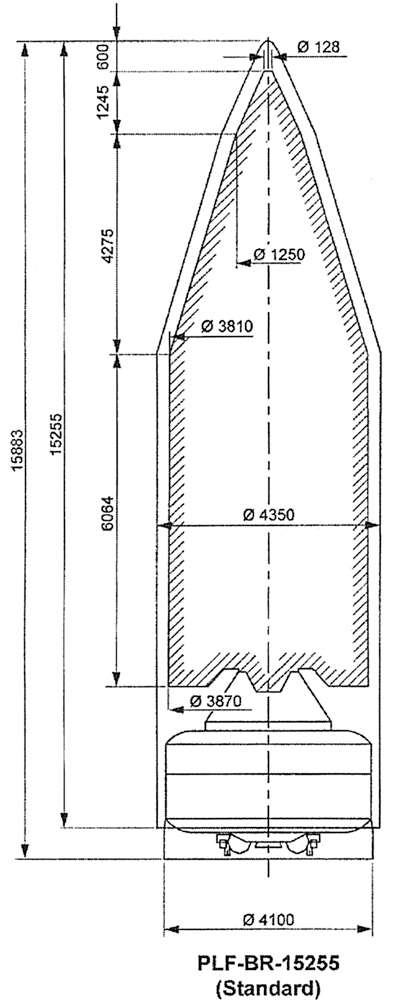Angara
Vehicle Design
Overall Vehicle

Angara 1.1 | Angara 1.2 | Angara A3 | Angara A5 | Angara A5/UOHM | |
Height | 34.9 m (114.5 ft) | 41.5 m (136.5 ft) | 45.8 m (150.2 ft) | 55.4 m (181.7 ft) | 64.0 m (209.9 ft) |
Gross Liftoff Mass | 149 t (329 klbm) | 171 t (377 klbm) | 480 t (1055 klbm) | 773 t (1705 klbm) | 790 t (1742 klbm) |
Thrust at Liftoff | 1920 kN (431 klbf) | 1920 kN (432 klbf) | 5760 kN (1259 klbf) | 9600 kN (2160 klbf) | 9600 kN (2160 klbf) |
Stages
The primary new element of the Angara is the new LOX/kerosene fueled Universal Module, also called a Common Rocket Module. This modular unit is used alone as a core stage, or in clusters as strap-on boosters. For example, the Angara 1.1 has a single core module, while the Angara A5 has a core module with four additional units added as strap-on boosters. In this respect, the Angara follows a modular approach similar to that used on the new Atlas V and Delta IV. Each module consists of a pair of cylindrical tanks and a single high-performance RD-191 engine. The RD-191 is a single-chamber derivative of the four-chamber RD-170/171 engines used to power both Energia and Zenit. While the RD-191 is a new engine, it shares a number of parts with the RD-170, so its development is considered to be simple and low-risk.
The second stage for the Angara 1.2 and larger vehicles is a LOX/kerosene fueled stage as well. This stage is powered by the RD-0124A engine, a new oxygen-rich, staged combustion engine with four thrust chambers. Development of this engine originally started as the RD-0124 for the planned upgrade of the Block I stage for the Soyuz ST, but it has been modified for use on Angara. Two variations of this stage will be used. The smaller one will be used on the Angara 1.2 and a stretched version used for the A3 and A5.
The Breeze M upper stage is used on the Angara 1.1 and the Angara A3, and optionally on the A5. The Breeze M is fueled with storable propellants, and has a toroid-shaped tank around the core stage that can be jettisoned. The Angara 1.1 uses as its second stage only the central element without the external tank. The full Breeze M can be used as a GTO injection stage on Angara A3 and A5. Breeze M was developed for Proton, and more information can be found in that chapter.
The Angara A5 will use a cryogenic upper stage called the KVRB to deliver payloads to GTO. The stage was originally designed for an upgrade of Proton, but it has not yet been used on that vehicle. The KVRB is related to the 12KRB hydrogen-fueled upper stage that Khrunichev built for India’s GSLV launch vehicle, but it has roughly 50% more propellant. The KVD-1M3 engine to be used on Angara has also apparently been uprated from the basic KVD-1M used on GSLV. Previously this has been described as a 75-kN (17-klbf) class thrust-level engine, but it will produce 100 kN (23 klbf) for Angara. The KVD-1M, also known as the 11D56M, is a derivative of the 11D56 engine developed between 1965 and 1972 for the fourth stage of a variant of the N-1 super-heavy lift launcher. It was never flown. Whereas engines in this class built in the rest of the world are usually expander cycles (like the RL10, Vinci, and LE-5) or gas-generator cycles (such as the HM-7B, and YF-75), the KVD-1M uses a more complex fuel-rich staged-combustion cycle similar to the Space Shuttle Main Engine with a single shaft turbopump. The KVRB stage is enclosed inside an external fairing. The LOX tank is mounted above the hydrogen tank, opposite the layout typically used for other cryogenic upper stages. Russia is the only significant space power that operates no cryogenic stages, a gap that would be filled when the KVRB is put into service. A future growth plan for the A5 involves replacing the second stage with a large hydrogen-fueled stage dubbed the Universal Oxygen/Hydrogen Module (UOHM, or UOHS, where S stands for “stage”). This would be powered by four KVD-1M engines.

Angara 1.1
Angara Universal Module | Stage 2 | Breeze M | KVRB | |
Dimensions | ||||
Length | 25 m (82 ft) | 6.9 m (22.6 ft) | 2.61 m (8.6 ft) | 10.1 m (33.1 ft) |
Diameter | 2.9 m (9.5 ft) | 3.6 m (11.8 ft) | 2.5 m (8.2 ft) | 3.8 m (12.5 ft) |
Mass | ||||
Propellant Mass | 132.6 t (292.3 klbm) Offloaded to 128.8 t (284 klbm) for Angara 1.2 only | 1.2: 25.7 t (56.6 klbm) A3 and A5: 35.7 t (78.7 klbm) | Core tank: 5200 kg (11,500 lbm) | 19.8 t (43.6 klbm) |
Inert Mass | 10 t (22 klbm) | ? | Core tank: 1100 kg (2400 lbm) | 3.5 t (7.7 klbm) |
Gross Mass | 142.6 t (314 klbm) | ? | Core only: 6300 kg (13,900 lbm) | 23.3 t (51.3 klbm) |
Propellant Mass Fraction | 0.93 | ? | 0.83 or 0.88 | 0.85 |
Structure | ||||
Type | ? | Skin-stringer | ? | ? |
Material | Aluminum? | Aluminum | Aluminum | Aluminum? |
Propulsion | ||||
Engine Designation | RD-191 (NPO Energomash) | RD-0124A (KB Khimavtomatiki) | S5.98M main engine (KB Khimavtomatiki) 11D458 verniers | KVD-1M3 (KB Khimavtomatiki) |
Number of Engines | 1 per core booster | 1 with 4 thrust chambers | 1 main engine + 4 vernier engines | 1 |
Propellant | LOX/RG-1 grade kerosene | LOX/kerosene | N2O4/UDMH | LOX/LH2 |
Average Thrust | Sea level: 1920 kN (431 klbf) | 294.3 kN (66.16 klbf) | Main engine: 19.62 kN (4410 lbf) | 100 kN (23 klbf) |
Isp | Sea level: 310.7 s | 359 s | Main engine: 325.5 s | 461 s |
Chamber Pressure | 257 bar (3725 psi) | 162 bar (2350 psi) | ? | ? |
Nozzle Expansion Ratio | ? | ? | ? | ? |
Propellant Feed System | Staged-combustion turbopump | Staged-combustion turbopump | Main engine: closed-cycle turbopump | Fuel-rich staged combustion turbopump |
Mixture Ratio (O/F) | 2.6:1 | 2.6:1 | 2.0:1 | ? |
Throttling Capability | 30–100% | 60% or 100% | 100% only | ? |
Restart Capability | No | No? | 8 total restarts | 5 restarts |
Tank Pressurization | LOX: Hot gaseous oxygen Fuel: Hot helium | Hot helium | Nitrogen | ? |
Attitude Control | ||||
Pitch, Yaw | Main engine gimbal ±8 deg | Main engine gimbal single plane ±4 deg | 12 ACS thrusters | Main-engine gimbal ±4 deg |
Roll | Four roll thrusters and two aerodynamic surfaces | Main engine gimbal single plane ±4 deg | 12 ACS thrusters | Roll-control thrusters |
Staging | ||||
Nominal Burn Time | 300 s maximum | 300 s ? | 425 s | ? |
Shutdown Process | Command? | Command shutdown | Command shutdown | Command shutdown |
Stage Separation | 4 retro-rockets | Spring ejection | ACS/Spring ejection of payload | ? |
Attitude Control System
The first stage controls attitude using a hydraulic nozzle gimbal on the RD-191 engine. The Breeze stage has 12 thrusters for attitude control. The RD-0124A engine can gimbal each of its four thrust chambers in a single plane to provide attitude control for the second stage. The KVRB upper stage uses a main engine nozzle gimbal as well as small roll control thrusters fueled by UDMH/N2O4.
Avionics
Angara uses an inertial guidance system and a digital flight computer derived from systems used on Proton M and Breeze M. The avionics are mounted on the Universal Module and on the second stage. The Breeze M upper stage has its own avionics, including power supply, inertial guidance, digital flight computer, and a telemetry system with onboard recording capability.
Payload Fairing
Several different payload fairings will be used on different Angara configurations. All fairings have options for spacecraft access doors and RF windows. The Angara 1.1 uses a modified Rockot payload fairing, which is designed to be compatible with the Breeze core upper stage. The Angara 1.2 uses a new PLF design in the standard two-stage configuration, though it too can use the Rockot payload fairing if a Breeze third stage is added. The Angara A3 will used a stretched version of the Proton M/Breeze M payload fairing, with the shorter, standard length version available if needed. Angara A5 will have different payload fairings for different upper-stage configurations. If the Breeze M upper stage is used, the same fairings from the Angara A3 are used. If the KVRB upper stage is used, a cylindrical fairing encapsulates the stage with a separate payload fairing mounted to the top. Two types of payload fairing will be available, a 4.3-m-diam and a larger 5.1-m-diam fairing.

Angara 1.1 fairing

Angara 3 fairing
Angara 1.1 | Angara 1.2 | Angara A3 | Angara A5 | |
Length | 6.735 m (22.1 ft) | 9.83 m (32.3 ft) | 11.6 m or 15.26 m | 4-m-diam fairing: 15.26, 16.57, 17.18 m (50.1, 54.4, 58.4 ft) 5-m-diam fairing: 19.65 m (64.5 ft) |
Primary Diameter | 2.5 x 2.62 m | 3.87 m (12.7 ft) | 4.35 m (14.3 ft) | 4.35 m or 5.1 m |
Mass | 710 kg (1565 lbm) | ? | 2200 kg or 2600 kg (4850 or 5730 lbm) | ? |
Structure | Carbon–fiber composite sandwich over aluminum honeycomb core | Carbon–fiber composite sandwich over aluminum honeycomb core | ||
Material | Composite and aluminum |